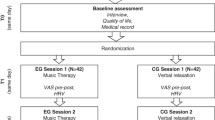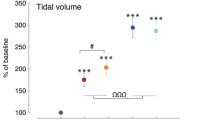Abstract
Quasiformal reports of widespread use of music in counterarousal techniques abound despite little evidence of its psychophysiological effects. Some known effects are presented here, and they suggest, among other things, an influence on hemispheric dominance, changes in autonomic nervous system activity, and relaxation by paradoxical arousal patterns contrary to those in cognitive function and anxiety. Hypothetical subcortical reflexes are postulated as mediators. Different types of music and their effect are described. Of particular relevance is that some forms of music have been reliably shown to have a profound beneficial effect on breathing.
Similar content being viewed by others
References
Altschuler, I. M. (1948). A psychiatrist's experience with music as a therapeutic agent. In D. M. Schullian & M. Schoen (Eds.),Music and medicine (pp. 266–281). New York: Schumann.
Bonny, H., & Savary, L. (1975).Music and your mind: Listening with a new consciousness. New York: Harper & Row.
Clynes, M. (1982).Music, mind, and brain. New York: Plenum.
Das, N. N., & Gasteau, H. (1957). Variations de l'activité électrique du cerveau, du coeur, et des muscles squeletiques au cours de la meditation et de l'extase yogique.EEG and Clinical Neurophysiology (Supplement),6 211–219.
Fried, R. (1987a).The hyperventilation syndrome — Research and clinical treatment. Baltimore: Johns Hopkins University Press.
Fried, R. (1987b). Relaxation with biofeedback-assisted guided imagery: The importance of breathing rate as an index of hypoarousal.Biofeedback and Self-Regulation, 12 273–279.
Fried, R. (1990).The breath connection. New York: Plenum.
Geschwind, N. (1974). The anatomical basis of hemispheric differentiation. In S. J. Dimond & J. G. Beaumont (Eds.):Hemisphere function in the human brain (pp. 7–24) New York: Halstead/John Wiley Press.
Halpern, S., & Savary, L. (1985).Sound health. New York: Harper & Row.
Hanser, S. B. (1985). Music therapy and stress reduction research.Journal of Music Therapy, 22 193–206.
Hanser, S. B. (1988). Controversy in music listening/stress reduction research.The Arts in Psychotherapy, 15 211–217.
Harrer, G., & Harrer, H. (1977). Music, emotion, and autonomic function. In M. Critchley & R. A. Henson (Eds.),Music and the brain (pp. 202–216). London: Heinemann Medical Books.
Kasamatsu, A., & Hirai, T. (1969). An electroencephalographic study of Zen meditation (Zazen).Psychologia, 12 205–225.
Kwalwasser, J. (1955).Exploring the musical mind. New York: Coleman-Ross.
McClelland, R. (1988).The healing forces of music. New York: Amity House.
Padus, E. (1986).Your emotions and your health. Emmaus, PA: Rodale Press.
Patel, C. (1975). 12-month follow-up of yoga and biofeedback in the management of hypertension.Lancet, 1 62–64.
Sherrington, C. S. (1906).The integrative action of the nervous system. New York: Yale University Press.
Standley, J. M. (1986). Music research in medical/dental treatment: Meta-analysis and clinical applications.Journal of Music Therapy, 23 56–122.
Taylor, I. A., & Paperte, F. (1958, September 3).Current theory and research in the effect of music on human behavior. Paper presented at the Music Research Foundation Symposium, New York Academy of Sciences.
Wallace, R. K., & Benson, H. (1972). The physiology of meditation.Scientific American, 226 84–90.
Author information
Authors and Affiliations
Additional information
A number of references cited in this report are based on anecdotal observations lacking empirical validation and should be interpreted in that vein. I thank Cheryl Marant for bringining to my attention several important articles on music and stress.
Rights and permissions
About this article
Cite this article
Fried, R. Integrating music in breathing training and relaxation: I. Background, rationale, and relevant elements. Biofeedback and Self-Regulation 15, 161–169 (1990). https://doi.org/10.1007/BF00999146
Issue Date:
DOI: https://doi.org/10.1007/BF00999146




